+ Open data
Open data
- Basic information
Basic information
| Entry |  | |||||||||
|---|---|---|---|---|---|---|---|---|---|---|
| Title | Cryo-EM structure of ETBR bound with Endothelin1 | |||||||||
 Map data Map data | ||||||||||
 Sample Sample |
| |||||||||
 Keywords Keywords | GPCR / COMPLEX / ETB / ENDOTHELIN-1 / SIGNALING PROTEIN | |||||||||
| Function / homology |  Function and homology information Function and homology informationenteric smooth muscle cell differentiation / response to endothelin / : / negative regulation of neuron maturation / endothelin A receptor binding / chordate pharynx development / rhythmic excitation / neuroblast migration / negative regulation of phospholipase C/protein kinase C signal transduction / endothelin receptor activity ...enteric smooth muscle cell differentiation / response to endothelin / : / negative regulation of neuron maturation / endothelin A receptor binding / chordate pharynx development / rhythmic excitation / neuroblast migration / negative regulation of phospholipase C/protein kinase C signal transduction / endothelin receptor activity / peptide hormone secretion / endothelin B receptor binding / aldosterone metabolic process / cellular response to human chorionic gonadotropin stimulus / meiotic cell cycle process involved in oocyte maturation / semaphorin-plexin signaling pathway involved in axon guidance / positive regulation of artery morphogenesis / histamine secretion / neural crest cell fate commitment / regulation of fever generation / vein smooth muscle contraction / glomerular endothelium development / response to prostaglandin F / sympathetic neuron axon guidance / positive regulation of penile erection / positive regulation of sarcomere organization / noradrenergic neuron differentiation / leukocyte activation / phospholipase D-activating G protein-coupled receptor signaling pathway / maternal process involved in parturition / positive regulation of chemokine-mediated signaling pathway / body fluid secretion / rough endoplasmic reticulum lumen / heparin proteoglycan metabolic process / posterior midgut development / positive regulation of renal sodium excretion / pharyngeal arch artery morphogenesis / regulation of D-glucose transmembrane transport / endothelin receptor signaling pathway involved in heart process / positive regulation of odontogenesis / epithelial fluid transport / cardiac neural crest cell migration involved in outflow tract morphogenesis / negative regulation of hormone secretion / response to ozone / endothelin receptor signaling pathway / Weibel-Palade body / podocyte differentiation / developmental pigmentation / positive regulation of cation channel activity / positive regulation of cell growth involved in cardiac muscle cell development / response to sodium phosphate / renal sodium excretion / response to leptin / enteric nervous system development / glomerular filtration / axonogenesis involved in innervation / renal sodium ion absorption / protein transmembrane transport / positive regulation of smooth muscle contraction / renin secretion into blood stream / artery smooth muscle contraction / renal albumin absorption / cellular response to follicle-stimulating hormone stimulus / positive regulation of prostaglandin secretion / cellular response to luteinizing hormone stimulus / respiratory gaseous exchange by respiratory system / vasoconstriction / cellular response to mineralocorticoid stimulus / regulation of pH / melanocyte differentiation / basal part of cell / peripheral nervous system development / type 1 angiotensin receptor binding / response to salt / negative regulation of adenylate cyclase activity / ganglioside catabolic process / positive regulation of urine volume / positive regulation of hormone secretion / regulation of systemic arterial blood pressure by endothelin / regulation of epithelial cell proliferation / cellular response to toxic substance / embryonic heart tube development / dorsal/ventral pattern formation / cellular response to fatty acid / establishment of endothelial barrier / axon extension / cartilage development / positive regulation of neutrophil chemotaxis / oligosaccharide catabolic process / neural crest cell migration / prostaglandin biosynthetic process / superoxide anion generation / signal transduction involved in regulation of gene expression / negative regulation of protein metabolic process / : / middle ear morphogenesis / nitric oxide transport / cellular response to glucocorticoid stimulus / response to pain / branching involved in blood vessel morphogenesis Similarity search - Function | |||||||||
| Biological species |  Homo sapiens (human) / Homo sapiens (human) /  | |||||||||
| Method | single particle reconstruction / cryo EM / Resolution: 3.26 Å | |||||||||
 Authors Authors | Hou JY / Liu SH / Wu LJ / Liu ZJ / Hua T | |||||||||
| Funding support | 1 items
| |||||||||
 Citation Citation |  Journal: Cell Discov / Year: 2024 Journal: Cell Discov / Year: 2024Title: Structural basis of antagonist selectivity in endothelin receptors. Authors: Junyi Hou / Shenhui Liu / Xiaodan Zhang / Guowei Tu / Lijie Wu / Yijie Zhang / Hao Yang / Xiangcheng Li / Junlin Liu / Longquan Jiang / Qiwen Tan / Fang Bai / Zhijie Liu / Changhong Miao / Tian Hua / Zhe Luo /  Abstract: Endothelins and their receptors, ET and ET, play vital roles in maintaining vascular homeostasis. Therapeutically targeting endothelin receptors, particularly through ET antagonists, has shown ...Endothelins and their receptors, ET and ET, play vital roles in maintaining vascular homeostasis. Therapeutically targeting endothelin receptors, particularly through ET antagonists, has shown efficacy in treating pulmonary arterial hypertension (PAH) and other cardiovascular- and renal-related diseases. Here we present cryo-electron microscopy structures of ET in complex with two PAH drugs, macitentan and ambrisentan, along with zibotentan, a selective ET antagonist, respectively. Notably, a specialized anti-ET antibody facilitated the structural elucidation. These structures, together with the active-state structures of ET-1-bound ET and ET, and the agonist BQ3020-bound ET, in complex with G, unveil the molecular basis of agonist/antagonist binding modes in endothelin receptors. Key residues that confer antagonist selectivity to endothelin receptors were identified along with the activation mechanism of ET. Furthermore, our results suggest that ECL2 in ET can serve as an epitope for antibody-mediated receptor antagonism. Collectively, these insights establish a robust theoretical framework for the rational design of small-molecule drugs and antibodies with selective activity against endothelin receptors. | |||||||||
| History |
|
- Structure visualization
Structure visualization
| Supplemental images |
|---|
- Downloads & links
Downloads & links
-EMDB archive
| Map data |  emd_38704.map.gz emd_38704.map.gz | 56.5 MB |  EMDB map data format EMDB map data format | |
|---|---|---|---|---|
| Header (meta data) |  emd-38704-v30.xml emd-38704-v30.xml emd-38704.xml emd-38704.xml | 20 KB 20 KB | Display Display |  EMDB header EMDB header |
| FSC (resolution estimation) |  emd_38704_fsc.xml emd_38704_fsc.xml | 8.4 KB | Display |  FSC data file FSC data file |
| Images |  emd_38704.png emd_38704.png | 72.9 KB | ||
| Filedesc metadata |  emd-38704.cif.gz emd-38704.cif.gz | 6.7 KB | ||
| Others |  emd_38704_half_map_1.map.gz emd_38704_half_map_1.map.gz emd_38704_half_map_2.map.gz emd_38704_half_map_2.map.gz | 59.4 MB 59.4 MB | ||
| Archive directory |  http://ftp.pdbj.org/pub/emdb/structures/EMD-38704 http://ftp.pdbj.org/pub/emdb/structures/EMD-38704 ftp://ftp.pdbj.org/pub/emdb/structures/EMD-38704 ftp://ftp.pdbj.org/pub/emdb/structures/EMD-38704 | HTTPS FTP |
-Validation report
| Summary document |  emd_38704_validation.pdf.gz emd_38704_validation.pdf.gz | 959.6 KB | Display |  EMDB validaton report EMDB validaton report |
|---|---|---|---|---|
| Full document |  emd_38704_full_validation.pdf.gz emd_38704_full_validation.pdf.gz | 959.1 KB | Display | |
| Data in XML |  emd_38704_validation.xml.gz emd_38704_validation.xml.gz | 16 KB | Display | |
| Data in CIF |  emd_38704_validation.cif.gz emd_38704_validation.cif.gz | 21 KB | Display | |
| Arichive directory |  https://ftp.pdbj.org/pub/emdb/validation_reports/EMD-38704 https://ftp.pdbj.org/pub/emdb/validation_reports/EMD-38704 ftp://ftp.pdbj.org/pub/emdb/validation_reports/EMD-38704 ftp://ftp.pdbj.org/pub/emdb/validation_reports/EMD-38704 | HTTPS FTP |
-Related structure data
| Related structure data | 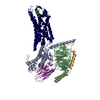 8xvhMC 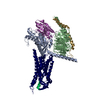 8xveC 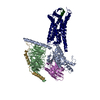 8xviC 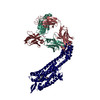 8xvjC  8xvkC  8xvlC M: atomic model generated by this map C: citing same article ( |
|---|---|
| Similar structure data | Similarity search - Function & homology  F&H Search F&H Search |
- Links
Links
| EMDB pages |  EMDB (EBI/PDBe) / EMDB (EBI/PDBe) /  EMDataResource EMDataResource |
|---|---|
| Related items in Molecule of the Month |
- Map
Map
| File |  Download / File: emd_38704.map.gz / Format: CCP4 / Size: 64 MB / Type: IMAGE STORED AS FLOATING POINT NUMBER (4 BYTES) Download / File: emd_38704.map.gz / Format: CCP4 / Size: 64 MB / Type: IMAGE STORED AS FLOATING POINT NUMBER (4 BYTES) | ||||||||||||||||||||||||||||||||||||
|---|---|---|---|---|---|---|---|---|---|---|---|---|---|---|---|---|---|---|---|---|---|---|---|---|---|---|---|---|---|---|---|---|---|---|---|---|---|
| Projections & slices | Image control
Images are generated by Spider. | ||||||||||||||||||||||||||||||||||||
| Voxel size | X=Y=Z: 0.96 Å | ||||||||||||||||||||||||||||||||||||
| Density |
| ||||||||||||||||||||||||||||||||||||
| Symmetry | Space group: 1 | ||||||||||||||||||||||||||||||||||||
| Details | EMDB XML:
|
-Supplemental data
- Sample components
Sample components
-Entire : Complex of protein Gs/q with ETB and Endothelin-1
| Entire | Name: Complex of protein Gs/q with ETB and Endothelin-1 |
|---|---|
| Components |
|
-Supramolecule #1: Complex of protein Gs/q with ETB and Endothelin-1
| Supramolecule | Name: Complex of protein Gs/q with ETB and Endothelin-1 / type: complex / ID: 1 / Parent: 0 / Macromolecule list: all |
|---|---|
| Source (natural) | Organism:  Homo sapiens (human) Homo sapiens (human) |
-Macromolecule #1: Isoform Gnas-2 of Guanine nucleotide-binding protein G(s) subunit...
| Macromolecule | Name: Isoform Gnas-2 of Guanine nucleotide-binding protein G(s) subunit alpha isoforms short type: protein_or_peptide / ID: 1 / Number of copies: 1 / Enantiomer: LEVO |
|---|---|
| Source (natural) | Organism:  Homo sapiens (human) Homo sapiens (human) |
| Molecular weight | Theoretical: 30.464314 KDa |
| Recombinant expression | Organism:  |
| Sequence | String: HHHHHHENLY FQGNSKTEDQ RNEEKAQREA NKKIEKQLQK DKQVYRATHR LLLLGADNSG KSTIVKQMRI LHGGSGGSGG TSGIFETKF QVDKVNFHMF DVGGQRDERR KWIQCFNDVT AIIFVVDSSD YNRLQEALNL FKSIWNNRWL RTISVILFLN K QDLLAEKV ...String: HHHHHHENLY FQGNSKTEDQ RNEEKAQREA NKKIEKQLQK DKQVYRATHR LLLLGADNSG KSTIVKQMRI LHGGSGGSGG TSGIFETKF QVDKVNFHMF DVGGQRDERR KWIQCFNDVT AIIFVVDSSD YNRLQEALNL FKSIWNNRWL RTISVILFLN K QDLLAEKV LAGKSKIEDY FPEFARYTTP EDATPEPGED PRVTRAKYFI RDEFLRISTA SGDGRHYCYP HFTCAVDTEN AR RIFNDCK DIILQMNLRE YNLV |
-Macromolecule #2: Guanine nucleotide-binding protein G(I)/G(S)/G(T) subunit beta-1
| Macromolecule | Name: Guanine nucleotide-binding protein G(I)/G(S)/G(T) subunit beta-1 type: protein_or_peptide / ID: 2 / Number of copies: 1 / Enantiomer: LEVO |
|---|---|
| Source (natural) | Organism:  Homo sapiens (human) Homo sapiens (human) |
| Molecular weight | Theoretical: 38.045629 KDa |
| Recombinant expression | Organism:  |
| Sequence | String: IGRARGFSEL DQLRQEAEQL KNQIRDARKA CADATLSQIT NNIDPVGRIQ MRTRRTLRGH LAKIYAMHWG TDSRLLVSAS QDGKLIIWD SYTTNKVHAI PLRSSWVMTC AYAPSGNYVA CGGLDNICSI YNLKTREGNV RVSRELAGHT GYLSCCRFLD D NQIVTSSG ...String: IGRARGFSEL DQLRQEAEQL KNQIRDARKA CADATLSQIT NNIDPVGRIQ MRTRRTLRGH LAKIYAMHWG TDSRLLVSAS QDGKLIIWD SYTTNKVHAI PLRSSWVMTC AYAPSGNYVA CGGLDNICSI YNLKTREGNV RVSRELAGHT GYLSCCRFLD D NQIVTSSG DTTCALWDIE TGQQTTTFTG HTGDVMSLSL APDTRLFVSG ACDASAKLWD VREGMCRQTF TGHESDINAI CF FPNGNAF ATGSDDATCR LFDLRADQEL MTYSHDNIIC GITSVSFSKS GRLLLAGYDD FNCNVWDALK ADRAGVLAGH DNR VSCLGV TDDGMAVATG SWDSFLKIWN UniProtKB: Guanine nucleotide-binding protein G(I)/G(S)/G(T) subunit beta-1 |
-Macromolecule #3: Guanine nucleotide-binding protein G(I)/G(S)/G(O) subunit gamma-2
| Macromolecule | Name: Guanine nucleotide-binding protein G(I)/G(S)/G(O) subunit gamma-2 type: protein_or_peptide / ID: 3 / Number of copies: 1 / Enantiomer: LEVO |
|---|---|
| Source (natural) | Organism:  Homo sapiens (human) Homo sapiens (human) |
| Molecular weight | Theoretical: 7.861143 KDa |
| Recombinant expression | Organism:  |
| Sequence | String: MASNNTASIA QARKLVEQLK MEANIDRIKV SKAAADLMAY CEAHAKEDPL LTPVPASENP FREKKFFCAI L UniProtKB: Guanine nucleotide-binding protein G(I)/G(S)/G(O) subunit gamma-2 |
-Macromolecule #4: Nanobody 35
| Macromolecule | Name: Nanobody 35 / type: protein_or_peptide / ID: 4 / Number of copies: 1 / Enantiomer: LEVO |
|---|---|
| Source (natural) | Organism:  |
| Molecular weight | Theoretical: 17.057271 KDa |
| Recombinant expression | Organism:  |
| Sequence | String: MKYLLPTAAA GLLLLAAQPA MAMQVQLQES GGGLVQPGGS LRLSCAASGF TFSNYKMNWV RQAPGKGLEW VSDISQSGAS ISYTGSVKG RFTISRDNAK NTLYLQMNSL KPEDTAVYYC ARCPAPFTRD CFDVTSTTYA YRGQGTQVTV SSHHHHHH |
-Macromolecule #5: Endothelin-1
| Macromolecule | Name: Endothelin-1 / type: protein_or_peptide / ID: 5 / Number of copies: 1 / Enantiomer: LEVO |
|---|---|
| Source (natural) | Organism:  Homo sapiens (human) Homo sapiens (human) |
| Molecular weight | Theoretical: 2.497951 KDa |
| Recombinant expression | Organism:  Homo sapiens (human) Homo sapiens (human) |
| Sequence | String: CSCSSLMDKE CVYFCHLDII W UniProtKB: Endothelin-1 |
-Macromolecule #6: Exo-alpha-sialidase,Endothelin receptor type B
| Macromolecule | Name: Exo-alpha-sialidase,Endothelin receptor type B / type: protein_or_peptide / ID: 6 / Number of copies: 1 / Enantiomer: LEVO / EC number: exo-alpha-sialidase |
|---|---|
| Source (natural) | Organism:  Homo sapiens (human) Homo sapiens (human) |
| Molecular weight | Theoretical: 94.123805 KDa |
| Recombinant expression | Organism:  |
| Sequence | String: MKTIIALSYI FCLVFADYKD DDDAGRAVEG AVKTEPVDLF HPGFLNSSNY RIPALFKTKE GTLIASIDAR RHGGADAPNN DIDTAVRRS EDGGKTWDEG QIIMDYPDKS SVIDTTLIQD DETGRIFLLV THFPSKYGFW NAGLGSGFKN IDGKEYLCLY D SSGKEFTV ...String: MKTIIALSYI FCLVFADYKD DDDAGRAVEG AVKTEPVDLF HPGFLNSSNY RIPALFKTKE GTLIASIDAR RHGGADAPNN DIDTAVRRS EDGGKTWDEG QIIMDYPDKS SVIDTTLIQD DETGRIFLLV THFPSKYGFW NAGLGSGFKN IDGKEYLCLY D SSGKEFTV RENVVYDKDS NKTEYTTNAL GDLFKNGTKI DNINSSTAPL KAKGTSYINL VYSDDDGKTW SEPQNINFQV KK DWMKFLG IAPGRGIQIK NGEHKGRIVV PVYYTNEKGK QSSAVIYSDD SGKNWTIGES PNDNRKLENG KIINSKTLSD DAP QLTECQ VVEMPNGQLK LFMRNLSGYL NIATSFDGGA TWDETVEKDT NVLEPYCQLS VINYSQKVDG KDAVIFSNPN ARSR SNGTV RIGLINQVGT YENGEPKYEF DWKYNKLVKP GYYAYSCLTE LSNGNIGLLY EGTPSEEMSY IEMNLKYLES GANKA PAEV PKGDRTAGSP PRTISPPPCQ GPIEIKETFK YINTVVSCLV FVLGIIGNST LLRIIYKNKC MRNGPNILIA SLALGD LLH IVIDIPINVY KLLAEDWPFG AEMCKLVPFI QKASVGITVL SLCALSIDRY RAVASWSRIK GIGVPKWTAV EIVLIWV VS VVLAVPEAIG FDIITMDYKG SYLRICLLHP VQKTAFMQFY KTAKDWWLFS FYFCLPLAIT AFFYTLMTCE MLRKKSGM Q IALNDHLKQR REVAKTVFCL VLVFALCWLP LHLSRILKLT LYNQNDPNRC ELLSFLLVLD YIGINMASLN SCINPIALY LVSKRFKNCF KSCLCCWCQL EVLFQGPHHH HHHHHHH UniProtKB: exo-alpha-sialidase, Endothelin receptor type B |
-Experimental details
-Structure determination
| Method | cryo EM |
|---|---|
 Processing Processing | single particle reconstruction |
| Aggregation state | particle |
- Sample preparation
Sample preparation
| Buffer | pH: 7.4 |
|---|---|
| Vitrification | Cryogen name: ETHANE |
- Electron microscopy
Electron microscopy
| Microscope | FEI TITAN KRIOS |
|---|---|
| Image recording | Film or detector model: FEI FALCON IV (4k x 4k) / Average electron dose: 60.0 e/Å2 |
| Electron beam | Acceleration voltage: 300 kV / Electron source:  FIELD EMISSION GUN FIELD EMISSION GUN |
| Electron optics | Illumination mode: FLOOD BEAM / Imaging mode: BRIGHT FIELD / Nominal defocus max: 2.0 µm / Nominal defocus min: 1.0 µm |
| Experimental equipment |  Model: Titan Krios / Image courtesy: FEI Company |
 Movie
Movie Controller
Controller






















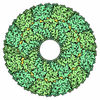











 Z (Sec.)
Z (Sec.) Y (Row.)
Y (Row.) X (Col.)
X (Col.)





















